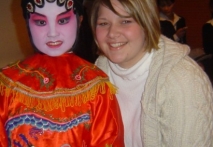学习心得
语风汉语学生Jennifer
学习心得
语风汉语学生Jennifer
我叫Jennifer,我非常喜欢在语风汉语无锡校学习汉语,这是一个非常好的学...
语风汉语无锡校 Zack
学习心得
语风汉语无锡校 Zack
我叫Zack,我是法国人,无锡语风汉教中心是一个学习中国文化和对外汉语的好...
语风汉语学生Kevin
学习心得
语风汉语学生Kevin
语风汉语是一个最理想的学习汉语和中国文化的好地方,学校给我们提供了很多...
语风汉语学生Florent
学习心得
语风汉语学生Florent
我非常喜欢无锡语风汉语学校,这里真的有最简单的汉语学习方法,我学习汉...
语风汉语学生Brad
学习心得
语风汉语学生Brad
我叫Brad,我是澳大利亚人,我再语风汉语学校学习汉语。我现在可以独立和我的...
语风汉语我的无锡学习汉语之路
学习心得
语风汉语我的无锡学习汉语之路
Cherry Queen 中文名: 钱沫以 &nbs...
无锡语风汉语优秀汉语学生Victoria
学习心得
无锡语风汉语优秀汉语学生Victoria
维多利亚Victoria,来自德国的一位11岁的小女孩 ,现读于语...
无锡语风汉语外国学生Michael的汉语学习之路
学习心得
无锡语风汉语外国学生Michael的汉语学习之路
Michael 刚刚来我们无锡语风汉语学校不久的美国学...
苏州汉语学生Jude
学习心得
苏州汉语学生Jude
我叫Jude,在苏州语风汉语学校学习汉语,我也在无锡语风汉语学校学习过很长时间...
无锡语风汉语学校Jessie
学习心得
无锡语风汉语学校Jessie
我学习汉语已经八年了,我能听明白别人说汉语,但是我自己说汉语却觉得说...
汉语 加官方
关注了解更多对外汉语资讯

0510-81151808
1866 1199 988
Sandy.Swun
519988808
无锡新区长江一号 茂业
深茂商务中心8号楼405室
无锡语风学校
语风汉语教学中心
无锡语风国际教育交流中心
Wuxi Mandarin Education School
Chinese grammar learning: the use of 就(jiù)
In Chinese language, the character就(jiù) is one of those very common parts of Chinese grammar that many students find confused. It says that 就 (jiù) doesn't have a corresponding meaning in English, but, frustratingly, that's all it says about it. What is the role of 就(jiù) in a Chinese sentence, and how is it needed and used in a more general sense in Mandarin?
1. Where should I place 就 in a sentence?
rder="1" style="border:medium none;background-color:#FFFFCC;width:365px;">
wŏmen xué wán le zhè kè kèwén
我们 学 完 了 这 课 课文
WE STUDY FINISH LE THIS KE LESSON
tā jiù néng huí jiā
他就 能 回 家
HE JIU CAN BACK HOME
He can go home as soon as we finish studying this lesson.
rder="1" style="border:medium none;background-color:#FFFFCC;width:365px;">
wŏ yì shuōhuà
我一 说话
I AS SOON AS SPEAK
tā jiù xiào
他 就 笑
HE JIU LAUGH
As soon as I speak he’ll laugh.
rder="1" style="border:medium none;background-color:#FFFFCC;width:365px;">
wŏ
我
I
bā diăn jiù lái le
八 点 就 来 了
8 O’ CLOCK JIU COME LE
I came here as early as 8 o’clock.
2. How do I use 就 to imply an action takes place earlier than I have expected?
就 can be placed after a time word to comment on the time which is earlier than you have expected.
rder="1" style="border:medium none;background-color:#FFFFCC;width:365px;">
tā
他
HE
jiŭ diăn jiù lái le xuéxiào
九点 就 来 了学校
9 O’ CLOCK JIU COME LE SCHOOL
He came to school as early as nine o'clock.
Comparing with 他九点来了学校. He came to school at 9.
3. Can 就 be used to imply anything else apart from “earlier than expected”?
就 can also be used to indicate that a preceded number word is a small number.
rder="1" style="border:medium none;background-color:#FFFFCC;width:365px;">
liăng ge rén
两 个人
TWO GE PEOPLE
jiù néng bàn hăo
就 能 办 好
JIUCAN DEAL WITH WELL/COMPLETE
......
It only takes two people to complete the job.
This sentence implies that the job is an easy one, and it only takes two people to complete. The speaker thinks two is a small number. 两个人能办好. It takes two people to complete the job. The speaker states a fact. The sentence has neither implicated the easiness nor the size of the number, which the above one has.
4. Can 就 be used for other purposes?
就 can also be used for emphasis.
rder="1" style="border:medium none;background-color:#FFFFCC;width:417px;">
tā jiù shi wŏ de lăo shī
他就是我的 老师
HE JIU IS MY TEACHER
He is my teacher.
jiù măi zhèxiē
就买 这些
JIU BUY THESE
I’ll just buy these.
wŏ jiù bú qù zhōngguó
我就不 去中国
I JIU NOT GO CHINA
I certainly don’t go to China.
就 is used in the following sentence constructions.
The following example shows that 就 is used to indicate that first action is immediately followed by second action.
rder="0" style="background-color:#FFFFCC;width:255.75pt;">
s. v.1 了 o.1
就 v.2 o.2 (了 )
tā xià le kè
他下 了课
HE FINISH LE LESSON
jiù qù tú shū guăn le 就去 图书馆 了
JIU GO LIBRARY LE
He went to the library after the class.
就 can also be used to indicate that as soon as the first action takes place, the second action will happen. The following pattern indicates that as soon as the action in the 一clause takes place, then it will be followed by the action which is in the 就 clause. Both 一 and 就 are adverbs, which should be placed before verbs. This pattern is often seen in a four-character expression.
rder="0" style="background-color:#FFFFCC;width:255pt;">
s. 一 v.1(o.1)
就 v.2 (o.2)
tā yì shōu
他一说
HE YI SPEAK
wŏ jiù kū
我 就 哭
I JIU CRY
A soon as he speaks I’ll start crying.
The difference between the above two examples is that the second example can be used for general descriptions, but the first is for a particular situation.










